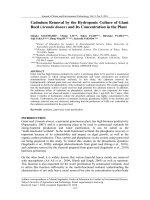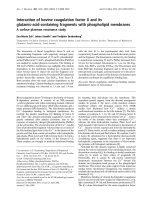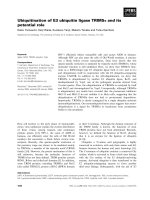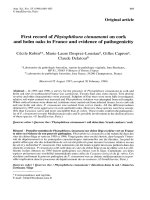First record of Anselmella malacia Xiao & Huang, 2006 (Hymenoptera: Eulophidae), a new insect pest of water apple (Syzygium samarangense) and its associated parasitoid in Dong Thap province,
Bạn đang xem bản rút gọn của tài liệu. Xem và tải ngay bản đầy đủ của tài liệu tại đây (635.61 KB, 8 trang )
TAP CHI SINH HOC 2019, 41(4): 7–14
DOI: 10.15625/0866-7160/v41n4.14673
FIRST RECORD OF Anselmella malacia Xiao & Huang, 2006 (Hymenoptera:
Eulophidae), A NEW INSECT PEST OF WATER APPLE (Syzygium
samarangense) AND ITS ASSOCIATED PARASITOID IN DONG THAP
PROVINCE, VIETNAM
Nguyen Thi Oanh1, Nguyen Kim Bup1, Khuat Dang Long2,*
1
2
Dong Thap University, Cao Lanh city, Dong Thap, Vietnam
Instititute of Ecology and Biological Resources, VAST, Ha Noi, Vietnam
Received 8 September 2019, accepted 10 December 2019
ABSTRACT
The eulophid wasp, Anselmella malacia Xiao & Huang, 2006 (Hymenoptera: Eulophidae), is
reared from fruits of the water apple, Syzygium samarangense, and is reported as an important
phytophagous developing as seed-eaters of Syzygium species in Malaysia. Analysing specimens
of pest insects infested inside of pear-shaped fruits of the cultivated water apple, S.
samarangense, in Dong Thap Province, South Vietnam, a total of four insect species were
recorded as the important pests for fruits of six varieties of the cultivated water apples. The
hymenoteran wasp, A. malacia, is recorded for the first time from Vietnam. Further evidence is
needed to prove A. malacia being an invasive pest in Vietnam. The associated hymenopteran
parasitoid assemblage with the fruit infested insect pests is also provided.
Keywords: Eulophidae, Anselmella, new pest, new record, parasitoid, phytophagous insects,
Vietnam.
Citation: Nguyen Thi Oanh, Nguyen Kim Bup, Khuat Dang Long, 2019. First record of Anselmella malacia Xiao &
Huang, 2006 (Hymenoptera: Eulophidae), a new insect pest of water apple (Syzygium samarangense) and its
associated parasitoid in Dong Thap Province, Vietnam. Tap chi Sinh hoc (Journal of Biology), 41(4): 7–14.
/>Corresponding author email:
©2019 Vietnam Academy of Science and Technology (VAST)
7
Nguyen Thi Oanh et al.
INTRODUCTION
Syzygium samarangense Merr. & Perry.
(Myrtaceae), commonly known as wax apple,
wax jambu, water apple, rose apple or Java
apple, has pear-shaped fruits and is common
in Cambodia, Laos, Thailand, Taiwan and
Vietnam, and is also frequently cultivated in
India, Pembe (Tanzania) and Zanzibar (Xiao
& Huang, 2006). The water apple is growing
in the most provinces in the southern
Vietnam. The pear-shaped fruits are often
juicy, with a subtle sweet taste somewhat
resembling a common apple, and especially,
this crop is considered as one of the special
precious fruits of Dong Thap Province.
Recently,
during
several
surveys
conducted in late March 2019 for revealing
parasitoids of fruit flies Bactrocera spp.
infested the water apple, we recognized a
community of hymenopteran wasps inside of
the fruits of cultivated water apple in several
areas of Dong Thap Province. Among
hymenopteran wasp adults, we recorded the
eulophid wasp, Anselmella malacia Xiao &
Huang, which causes a heavy damage to the
cultivated water apples in Cao Lanh City and
its vicinity.
MATERIALS AND METHODS
All the specimens examined in this study
were collected from water apple fruits in Cao
Lanh City, Dong Thap Province, in late
March 2019. Since it is rather difficult to
obtain reliable estimates of abundance of
species inside the cavity of water apple fruits,
the relative abundance data are collected by
complete
enumeration,
counting
all
individuals found in well-defined demaging
fruits, then the comparative abundunce of
insect pests are expressed in percentage.
Identification of pest insects and their
associated parasitoids is based on the
following literatures: Doganlar & Hassan
(2010), Han et al. (2017), Leblanc et al.
(2018), Li et al. (2013), Xiao et al. (2006),
Yang et al. (2014). Anselmella malacia was
identified by the comparison of the
morphological characters of the pest
population collected from six verieties of the
8
cultivated water apples in Cao Lanh, Dong
Thap, with the original description of Xiao et
al. (2006). Measurements of A. malacia adults
were made using a binocular microscope
(DK3000; Meiji Techno Co., Ltd., Saitama,
Japan).
All the research specimens are deposited
in the Institute of Ecology and Biological
Resources (Ha Noi, Vietnam) and Dong Thap
University (Cao Lanh, Dong Thap, Vietnam).
RESULTS
Pest insects associated with the fruit of
cultivated
water
apple,
Syzygium
samarangense
Of the most commonly sampled species,
one was a seed-eater of Syzygium varieties:
Anselmella malacia Xiao & Huang
(Hymenoptera, Eulophidae), and three others
were frugivorous insects, Bactrocera dorsalis
(Diptera, Tephritiidae); Orgyia postica
(Walker) (Lepidoptera, Erebidae); and Cydia
sp. (Lepidoptera, Tortricidae) (Table 1).
The seed-eater A. malacia and frugivore B.
dorsalis were found as the most abundant
species in the samples (> 50%). Especially, in
the fruits of two varieties Hong Dao Da and
Hoa An planted in Dong Thap Province, up to
100% of the sampled specimens were of the
seed-eater A. malacia.
Seeds attacked by the seed-eater A. malacia
contained cavities and frass made by larvae
and were often galled with a mass of pale
conductive tissue and parenchyma, rather than
green cotyledons (Fig 1). The effect of the
seed-eater and other frugivorous insects on the
viability of the seed in samples was not
quantified. Nevertheless, seedlings were able
to germinate from the most severely damaged
fruits and seeds by the end of the trial.
Of total five insect species recorded from
six varieties of the cultivated Syzygium
samarangense in Cao Lanh city, Dong Thap
Province, in addition to A. malacia, we have
found another hymenopteran species,
Megastigmus sp. and two lepidopteran
First record of Anselmella malacia
species, Orgyia postica and Cydia sp. Orgyia
postica was reported as the restrictively
distributed fugivore in Vietnam (Waterhouse,
1993; CABI, 2019). Another frugivorous
insect, Cydia sp. is also an abundant pest, i.e.
25–50% of the sampled specimens of the pest
complex infested the water apple in Dong
Thap Province.
Table 1. Assemblage of pest insects found in fruits of S. samarangense
in Cao Lanh City and its vicinity
Local varieties of Syzygium
Pest species
Xanh
Hong
An
Sua
Hoa An
Duong
Dao Da
Phuoc
Diptera, Tephritiidae
Bactrocera dorsalis (Hendel,
> 50%
> 50%
> 50%
< 25%
> 50%
1912) (oriental fruit fly)
Hymenoptera, Eulophidae
Anselmella malacia Xiao &
25–50%
> 50% 25–50% < 25%
> 50%
Huang, 2006
Torimidae
Megastigmus sp.
Lepidoptera
Erebidae
Orgyia postica (Walker,
< 25%
25–50%
< 25%
< 25% 25–50%
1955) (cocoa tussock moth)
Tortricidae
Cydia sp.
< 25%
25–50%
25–50%
-
Indian
< 25%
-
-
Figure 1. Healthy water apple fruit (left) and the fruit damaged by Anselmella malacia (right)
Figure 2. Damages inside of water apple fruits caused by Bactrocera dorsalis Xanh Duong
variety (left), Hong Dao Da variety (middle) and Indian variety (right)
9
Nguyen Thi Oanh et al.
Morphology of A. malacia collected from
the water apple in Cao Lanh, Dong Thap
Based on the comparative characters of
the wasp seed-eater infested Syzygium
samarangense in Cao Lanh city, Dong Thap
Province, it is possible to confirm this pest is
Anselmella malacia Xiao & Huang rather
than Anselmella miltoni Girault (table 2).
Table 2. Comparative characters of Anselmella malacia Xiao & Hoang, 2006
Anselmella malacia
Anselmella malacia
Characters
(Original
(from Dong Thap,
description)
Vietnam, n = 30)
Eye height : Malar space
2.6 ×
2.80 ± 0.18
Head width : Head height (frontal view)
1.3 ×
1.30 ± 0.04
Head width : Head length (dorsal view)
1.95 ×
2.04 ± 0.15
Head width : Mouth width
2.4 ×
2.40 ± 0.09
Eye height : Eye length
1.2 ×
1.18 ± 0.06
POL : OOL
2.9 ×
2.70 ± 0.32
Eye length : Temple (dorsal view)
20.0 ×
19.55 ± 1.06
Scapus length : maximum width
1.9 ×
1.87 ± 0.23
MV : PMV
2.3 ×
2.18 ± 0.31
PMV : STV
0.2 ×
0.25 ± 0.03
Metasoma length : width
1.5 ×
1.50 ± 0.18
Body length (female)
2.2 mm
2.54 ± 0.16 mm
Body length (male)
1.5–2.0 mm
1.74 ± 0.38 mm
Notes: MV = Marginal vein; PMV = Postmarginal vein; SMV = Submarginal vein; STV = Stigmal vein.
Preliminary biological characteristics of A.
Malacia
Emerged adults were separated into males
and females, and pairs of males and females
were observed separately. While sucking
flower nectar, A. malacia females prefer
laying their eggs inside the most soft tissue of
flower style during the anthesis stage of fruit
phenology of S. samarangense (Fig. 3A),
where eggs were laid as the clusters (Fig. 3B)
or masses (Fig. 3C) and were white or creamy
white, oval in shape (Figs. 3B–3C).
Figure 3. A = Hole made by A. malacia female on flower style; B and C = Clusters/masses
of eggs inside of flower ovaries
The egg stage of A. malacia overlaps with
the petal fall stage in S. samarangense.
10
Immature stage of A. malacia develops
through a rapid stage to the middle fruit stage.
First record of Anselmella malacia
Anselmella malacia enters into pupal stage
and adults emerge, when the fruits of S.
samarangense are in the mature stage.
After hatched from eggs inside the
fruilets, larvae feed on the internal tissues of
water apple fruits, larval and pupal stages lasts
inside the fruits. Adults are emerged inside of
the fruit cavity, where several holes are left
(Figs. 4 A & B).
In this study, another hymenopteran
wasp, Megastigmus sp. (Hymenoptera;
Chalcidoidea: Torymidae), was found in the
cavity of water apple fruits in Cao Lanh,
Dong Thap (Fig. 5). In some published
literatures (Roques et al., 1995; Roques et
al., 2016), this wasp species was recorded
and reported as a seed-feeding that emerged
from seeds of wild rose, Rosa canina, in
Ukraine. According to Doganlar & Hassan
(2010), Australian species of Megastigmus
were recorded as pests associated with
Eucalyptus plants.
Figure 4. A & B = Holes after A. malacia adults emerged outside of the fruit cavity
Figure 5. Megastigmus sp. (Habitus, female)
Hymenopteran parasitoid associated with
the fruit infested insect pests
One
dominant
parasitic
wasp,
Aprostocetus
sp.
(Hymenoptera:
Chalcidoidea: Eulophidae) (Fig. 6), was
surveyed and collected from water apple fruits
in Cao Lanh City, Dong Thap Province, in
March 2019, and this parasitoid is probably an
11
Nguyen Thi Oanh et al.
egg parasitoid of A. malacia because the
parasitic wasp was not directly reared from
Anselmella malacia but parasitoid was
incidentally captured inside of water apple
fruits when the fruits were collected.
However, two species of the genus
Aprostocetus, A. causalis La Salle & Wu,
from China and Thailand and A. felix La Salle,
Yang & Lin, from Taiwan, were reported as
fortuitous parasitoids of invasive eulophid gall
inducers (Tetrastichinae) on Eucalyptus and
Erythrina (Yang et al., 2014).
Figure 6. Aprostocetus sp. (Habitus, male)
DISCUSSION
Based on the comparative morphological
characters of the eulophids collected from
fruits of Syzygium samarangense in Cao
Lanh city, Dong Thap, Anselmella malacia
was revealed as one of few gall-inducing
hymenopteran wasps living inside of fruits
and this pest was recorded for the first time
in Vietnam. Inducing galls within the seed
chamber of the fruits of the water apple
fruits, A. malacia has emerged as a serious
problem for all the varieties of the cultivated
S. samarangense in Cao Lanh City, Dong
Thap Province.
Contrary to the frugivorous insect,
Bactrocera dorsalis (Diptera: Tephritidae),
which induces either an immature fruit drop
or decay in pulp in the cultivated water apple,
A. malacia should be considered as an issue of
deep concern for the horticultural industry not
12
only in Dong Thap Province, but all over
Vietnam. Since there is not any practice
applied for the control of A. malacia up to
know, control measures should be introduced
in the studied area as soon as possible.
REFERENCES
CAB International, 2019. Available from:
/>todistributionTable
(accessed
16
November 2019).
Doganlar M., Hassan E., 2010. Review of
Australian Species of Megastigmus
(Hymenoptera: Torymidae) Associated
with Eucalyptus, with Descriptions of
New Species. Australian Journal of Basic
and Applied Sciences, 4(10): 5059–5120.
Han H. Y., Choi D. S., Ro K. E., 2017.
Taxonomy of Korean Bactrocera (Diptera:
Tephritidae: Dacinae) with review of their
First record of Anselmella malacia
biology.
Journal
of
Asia-Pacific
Entomology, 20: 1321–1332.
Juniper P. A., David R Britton D. R., 2010.
Insects associated with the fruit of
Syzygium
paniculatum
(Magenta
Lillypilly) and Syzygium australe (Brush
Cherry).
Australian
Journal
of
Entomology,
49(4):
296–303.
/>Kapoor V. C., 2005. Taxonomy and Biology
of Economically Important Fruit Flies of
India. Isr. J. Entomol., 35(36): 459–475.
Leblanc L., Doorenweerd C., Jose M. S., Pham
H. T., Rubinoff D., 2018. Descriptions of
four new species of Bactrocera and new
country records highlight the high
biodiversity of fruit flies in Vietnam
(Diptera, Tephritidae, Dacinae). ZooKeys,
797: 87–115. />zookeys.797.29138
Le Duc Khanh, Nguyen Thi Thanh Hien, Tran
Thanh Toan, Vu Thi Thuy Trang, Le
Quang Khai, Vu Van Thanh, Dang Dinh
Thang, Nguyen Thi Thuy Hang, 2010.
Thanh phan ruoi hai qua ho Tephretidae
va ky chu cua chung tai mot so vung sinh
thai nong nghiep Vietnam. Tap chi Bao ve
thuc vat, no. 3: 10–14 (in Vietnamese with
English sumary).
Leung W. T. W., Butrum R. R., Chang F. H.,
Rao M. N., Polacchi W., 1972. Food
composition table for use in East Asia.
FAO, Rome, 347 pp.
Li X-Y., Achterberg C. van, Tan J-C., 2013.
Revision of the subfamily Opiinae
(Hymenoptera, Braconidae) from Hunan
(China), including thirty-six new species
and two new genera. ZooKeys, 268: 1–
168.
/>268.407
Lim T. K., 2012. Edible Medicinal And NonMedicinal Plants: Volume 3, Fruits.
Springer Science & Business Media B. V.,
pp. 778–786.
Lin Y-C., Liao Y-C., Yang M-M., 2019.
Biology of a Gall-inducing Species of
Anselmella
(Hymenoptera:Eulophidae)
within
the
Fruits
of
Syzygium
samarangense (Myrtaceae). Formosan
Entomol., 38(Special Issue): 56–68.
Roques A., Sun J-H, Pan Y-Zh, Zhang X-D,
1995. Contribution to the knowledge of
seed
chalcids,
Megastigmus
spp.
(Hymenoptera: Torymidae), in China,
with the description of three new species.
Journal of the Swiss Entomological
Society, 68(1–2): 211–223. />10.5169/seals-402594
Roques A., Copeland R. S., Soldati L., Denux
O., Auger-Rozenberg M. A., 2016.
Megastigmus
seed
chalcids
(Hymenoptera, Torymidae) radiated much
more on Angiosperms than previously
considered. I- Description of 8 new
species from Kenya, with a key to the
females of Eastern and Southern Africa.
ZooKeys, 585: 51–124. />10.3897/zookeys.585.7503
Rosnah S., Wong W. K., Noraziah M. and
Osman H., 2012. Chemical composition
changes of two water apple (Syzygium
samaragense).
International
Food
Research Journal, 19(1): 167–174.
Shu Z. H., Meon R., Tirtawinata, Thanarut C.
2006. Wax apple production in selected
tropical Asian countries, ISHS, Acta Hort,
(ISHS), 773: 161–164.
Turgeon J. J., Kamijo K., DeBarr G., 1997. A
new species of Megastigmus Dalman
(Hymenoptera: Torymidae) reared from
seeds
of
Atlantic
white
cedar
(Cupressaceae), with notes on infestation
rates. Proceedings of the Entomological
Society of Washington, 99(4): 608–613.
Wharton R. A., 1997. Generic relationships of
opiine
Braconidae
(Hymenoptera)
parasitic in fruit-infesteing Tephritidae
(Diptera). Contributions of the Americal
Entomological Instite, 30(3): 1–53.
Waterhouse D. F., 1993. The Major
Arthropod Pests and Weeds of Agriculture
in Southeast Asia. ACIAR Monograph
13
Nguyen Thi Oanh et al.
No. 21. Canberra, Australia: Australian
Centre for International Agricultural
Research, 141 pp.
Xiao H., Xu L-N., Huang D-W., Zhao Z-Y.,
2006. Anselmella malacia, A New Pest
Wasp
(Hymenoptera:
Chalcidoidea:
Eulophidae) reared from Syzygium
samarangense
in
Malaysia.
Phytoparasitica, 34(3): 261–264.
14
Yang M-M., Lin Y-C., Wu Y., Fisher N.,
Saimanee T., Sangtongpraow B., Zhu C.,
Chiu W. C.-H. and Salle J. L., 2014. Two
new Aprostocetus species (Hymenoptera:
Eulophidae: Tetrastichinae), fortuitous
parasitoids of invasive eulophid gall
inducers (Tetrastichinae) on Eucalyptus
and Erythrina. Zootaxa, 3846(2): 261–272.
/>









